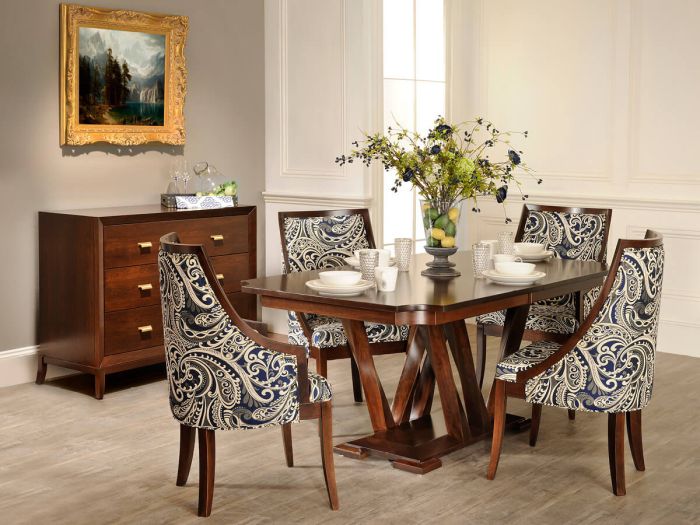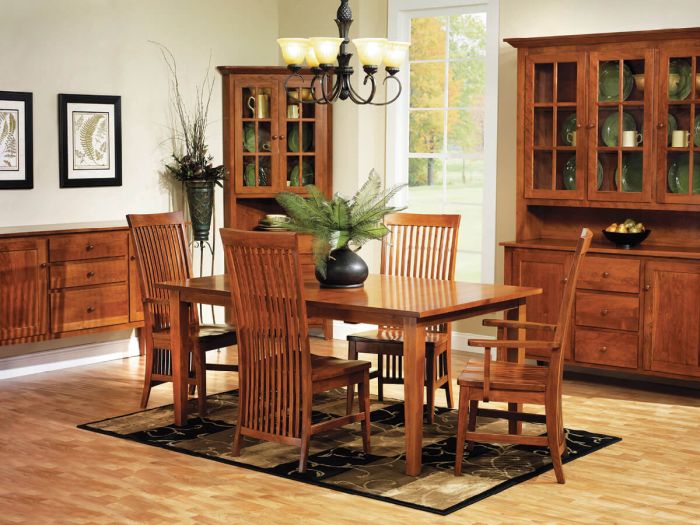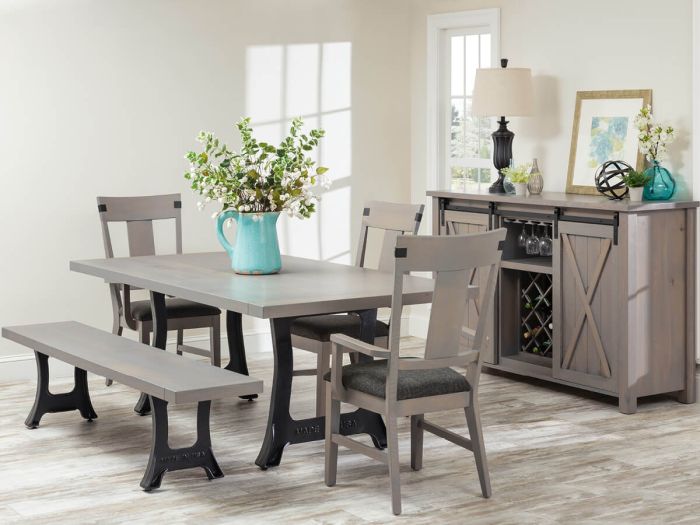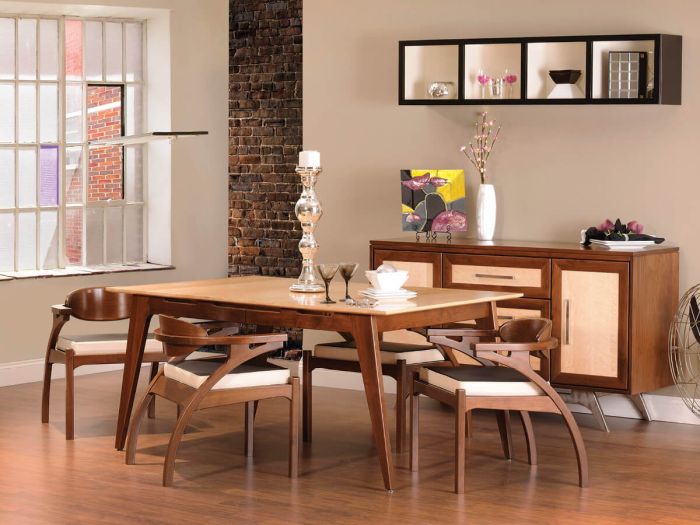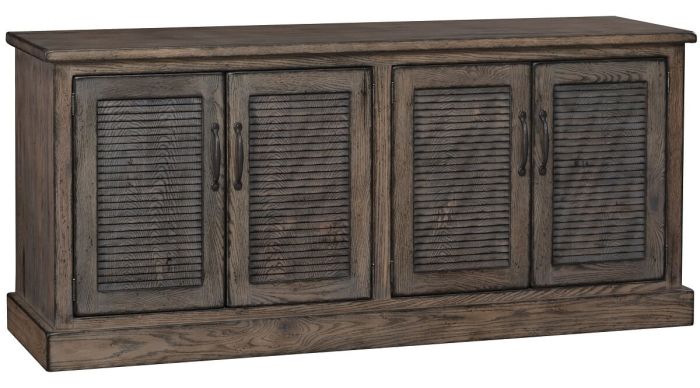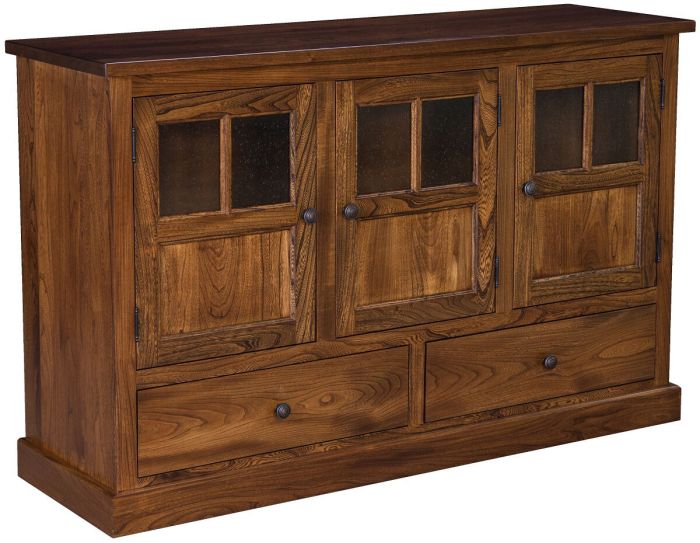Buyers’ Guide to Dining Room Sideboards and Buffets
By Bailiegh Basham · October 21, 2021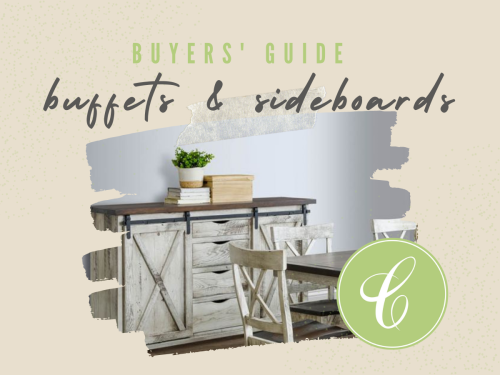
A dining room is one of the most elegant rooms in the home. It’s the place where you can gather for a family meal, host friends and family for holiday dinners, or display your prized collection of antique dishware. If you’re looking for ways to enhance the look of the room or add handy storage and display space, consider adding a sideboard to your dining room. The advantages of a sideboard in your dining room are many and will make the investment a worthwhile one for your home.
First off, what is a sideboard? A sideboard, more commonly known as a buffet, is a cabinet that stands freely in a kitchen or dining room. Its layout usually includes a set of cabinets and drawers, topped with a wooden top for holding food, dishes, and decorative items.
This elegant piece could be called a buffet since it is being used in the dining room. If you put the same piece in the entryway or living room, it would probably be called a sideboard, console, or simply a cabinet. Although traditionally a sideboard was intended to be used in a formal, separate dining room, that’s certainly no longer the case, as they now regularly feature in kitchens and living rooms, and even sometimes in bedrooms or hallways.
Before shopping, consider the desired function and form of a sideboard. It is important to choose the right shape and style to suit your space and your needs: how often do you entertain, what do you need to store, etc. Choose a functional piece that coordinates with your existing colors and style or select one that makes a bold statement in the room. It's an attractive way to keep clutter out of the way. Whether you have a grand formal dining room, a relaxed dedicated dining room, or an open plan living, kitchen and dining space, a sideboard or buffet is a great furniture investment.
What is a sideboard?
Sideboards have been a home decoration staple, even before the days of fitted cabinets. Sideboards emerged in England in the 18th and 19th centuries as a dining room furniture piece popular in affluent homes. During this time, households became prosperous enough to dedicate a room solely to dining. They were often decorative pieces that were used to store more general items than serving ware alone. The English sideboard would traditionally stand against the back wall of a dining room at about waist height.
What is the difference between a sideboard and a buffet? The terms are occasionally used interchangeably, though there are some distinct aspects to each. The only real difference between a sideboard and a buffet is the room in which they are traditionally found. Sideboards are classically found in the living room, whereas a buffet lives in the dining room.
When searching for the ideal sideboard or buffet, be sure to consider the item’s construction and materials. You can find sideboards constructed of just about any material you can think of, though hardwood is the most popular. There are so many reasons to appreciate wood in this regard: natural beauty, grain variation, excellent aging, and the sheer variety of finishes that can be applied to it are just a few. Not to mention, if properly cared for, Amish solid wood furniture will last for generations. Materials can also add decorative elements. For example, choosing a unit with glass doors may brighten up your space, whereas metal hardware may add a contemporary feel to the piece. Because everyone’s preferences and needs are different, the most important thing is that the material you opt for is high-quality and will look great in your intended location.
Form & Function
Next, consider what functionality is most important. Sideboards are a great solution if you find yourself constantly needing extra storage space. The upper drawers of these tables are often specifically designed for the purpose of storing small, sometimes delicate cutlery and decorations, while the larger cabinets provide a safe, out-of-the-way location to store dishes and more. The surface or top of a sideboard is a great place to display collectible plates, family photos, and prized decorative items.
Why do you need this sideboard?
When you’re looking for dining room storage, allow your storage needs and decorative tastes to be the criteria that help you pick the best piece. Think about details such as whether you need closed or open storage (i.e.., cabinets or shelves). Cabinets can hide clutter while shelves both keep items handy and put decorative pieces on display. Open shelving has a lighter, more approachable feel, but enclosed cabinets can be handy if you have an abundance of dining essentials. If you just can’t choose, you can always go with glass cabinet doors. You can simply use this piece for storing crockery or serving gear when it’s not in use, or just for general storage as well.
If you’re not that concerned about serving space, you can always use the surface for a gorgeous stylistic display of plants, artwork, photographs, and any other decorative pieces you might want to show off.
When will it be used?
Will your buffet be used every day or on special occasions? If you are looking for a furniture piece in which to display your fine china and crystal, as well as to provide storage for other items like linens and silverware, look for a buffet with glass doors on top and drawers and cupboards at the bottom.
For those who entertain often or enjoy huge holiday gatherings, choosing a buffet with a large top surface will allow for maximum serving space. If you throw casual dinner parties where your guests help themselves from a variety of food laid out, a long, low buffet might be just what you’re looking for.
Where will it be placed?
While buffet cabinets traditionally are used in the dining room, there is no reason to limit them to that location. If you need storage in a hallway or a catchall surface in your foyer, a buffet is just the ticket. Sideboards may also be placed in bedrooms, nurseries, and even office spaces.
Wherever you decide to place your buffet cabinet, it is important to choose one that is proportionate to the size of the space. Though sideboards are usually long, you want it to be the right size so it fits your dining room and looks proportioned with your table. A buffet has an average width of 60 inches, which would work well for a dining room table of the same length or longer. But a 60-inch long sideboard could overpower a petite table that seats four. Also, consider buying a credenza, sideboard, or buffet that’s slightly higher than the dining room table. In dining areas, a minimum 36-inch space between the edge of your table and your credenza is necessary to avoid a cramped,
However, if you can’t find a buffet that’s a suitable size, it might also be worth considering something like a console table, that will be smaller and slimmer, whilst still offering some storage capacity.
Style Considerations
Buffets and sideboards can either match your dining room set and decor or are vastly different in style for a more modern, eclectic look. If your dining room set didn't come with a buffet or sideboard, you can still find one in a similar style, even if it's not a perfect match. Or consider adding a bright contrasting color into any style of a dining room by choosing a painted buffet or sideboard, especially if you want to modernize an otherwise traditional dining room.
Why do you like it?
- Which features will you use most often?
- Which convenient special features are available?
- Which stylistic elements do you like the best?
- Does it complement your existing decor?
What’s your style?
Finally, style. Look for a piece that blends seamlessly into your home. Sideboards and buffets are traditionally rather formal, but with all the contemporary design options out there this doesn’t have to be a rule. With endless designs and configurations, it’s important to list your personal preferences. Keeping the true purpose of credenzas in mind – storage and display – along with your own style and decor preferences will help you decide which style is right for you.
Traditional: For a classic home that doesn’t need a complete overhaul every time home decor trends shift, traditional credenzas are the sweet spot. Heavy wood, detailed carvings, and a more formal feel mark these credenzas.
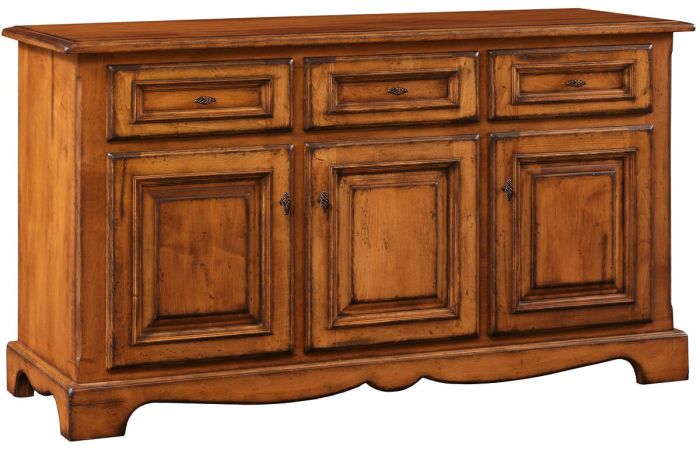
Contemporary: This type of credenza is most suitable for the office with modern interior designs. More often than not, it has a bare look and it can be used to merge effectively with other trends of office furniture.
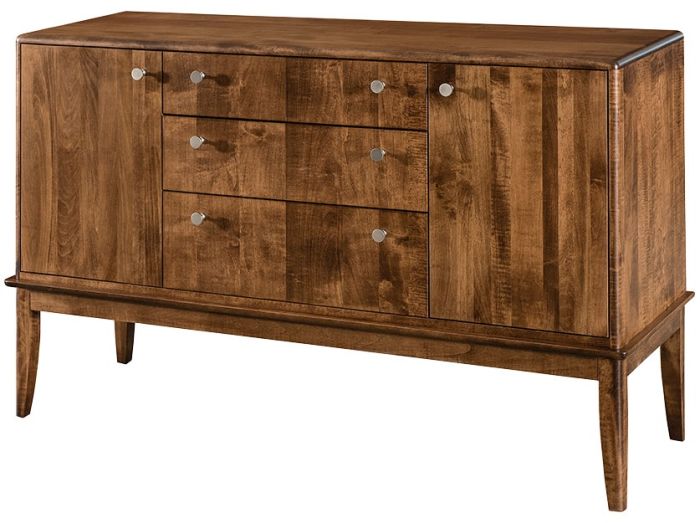
Rustic: Try a rustic sideboard if your dining room or living room encompasses a natural, rugged feel. This style exchanges frills for raw wood in neutral colors, and natural or added distressing brings one of a kind charm.
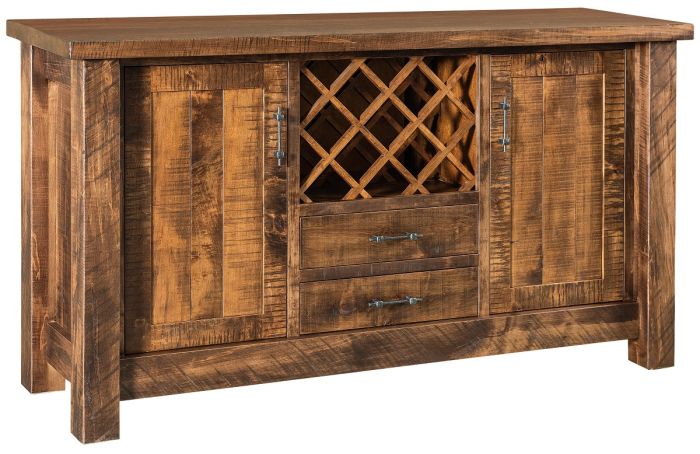
Farmhouse: If your dining room is reminiscent of a warm cottage or homestead, consider a farmhouse sideboard or buffet. Farmhouse style is light and clean in color - think gray stains or painted finishes - with accents of distressed wood.
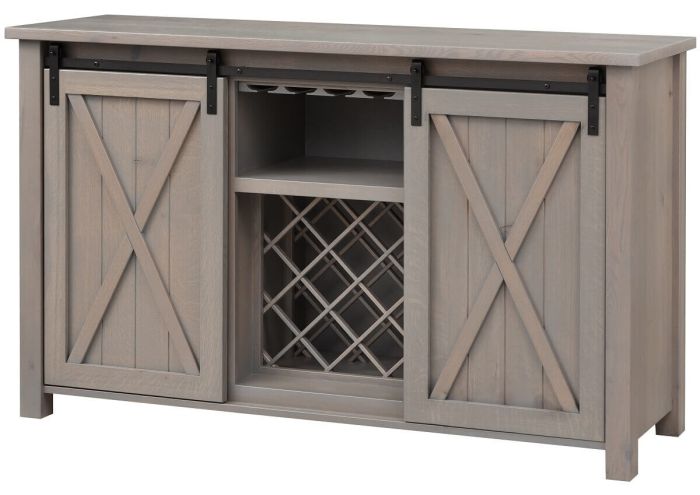
Industrial: Combining metal with wood, these sideboards look at home as part of any loft-style interior. Their edgy, urban appeal makes them a stylish fit for apartments or spaces such as a renovated warehouse.
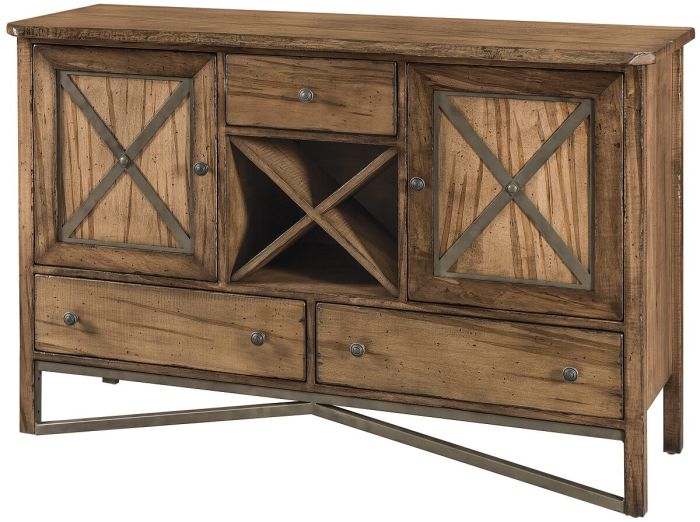
Mid-century: This type of sideboard is minimalist but refined. The resurgence of mid-century style brings clean, smooth lines to your modern space and a pop of retro flair. Plus, who doesn’t love the look of geometric designs and tapered legs?
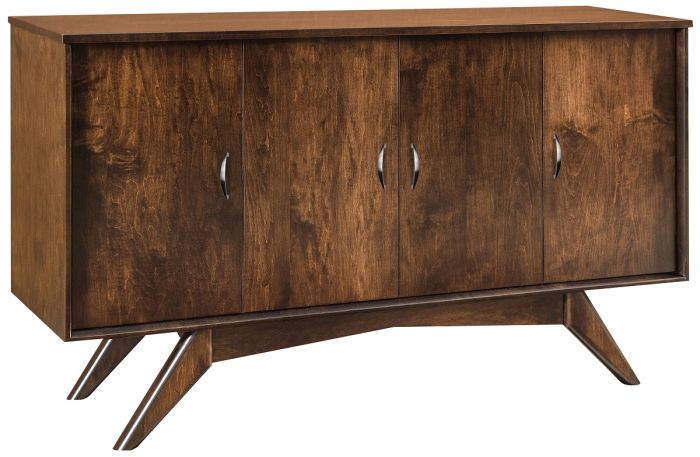
Mission: Simple and practical, mission-style furniture places a heavy emphasis on the artistry of woodworking and the value of well-made pieces. Mission sideboards often boast solid Oak or Quartersawn White Oak construction with exposed mortise and tenon joinery.
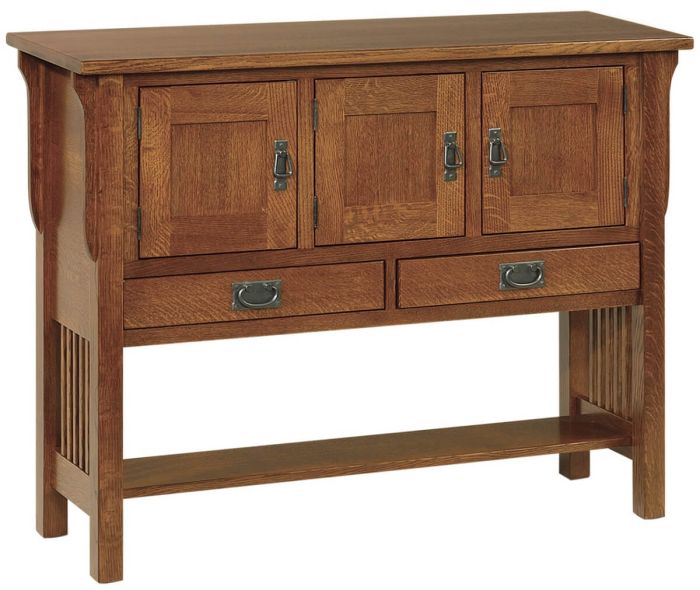
Shaker: Shaker buffets are characterized by clean lines, tapered legs, and simple forms. Shaker craftsmanship was based on design principles of truth to materials and form follows function, creating an enduring aesthetic with a long-lasting appeal.
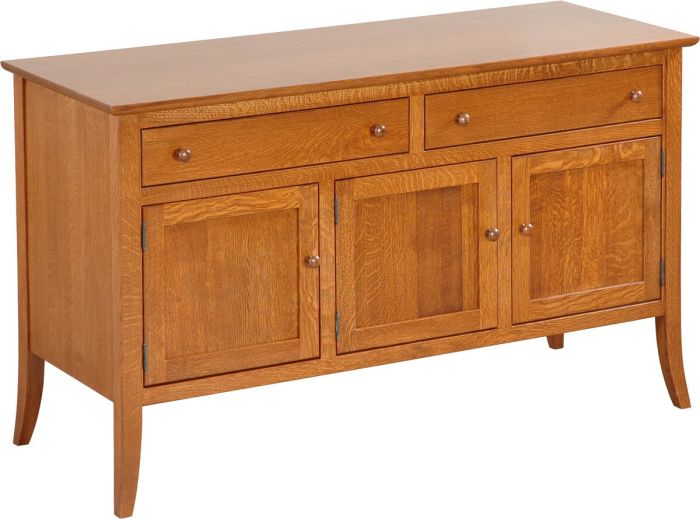
Reclaimed: Reclaimed wood dining room furniture is one of the most popular choices of furniture at the moment. Not only is it environmentally friendly, but it’s got a distinctive and unique look, and it’s also usually more robust than most, with the wood being sourced from old structures.
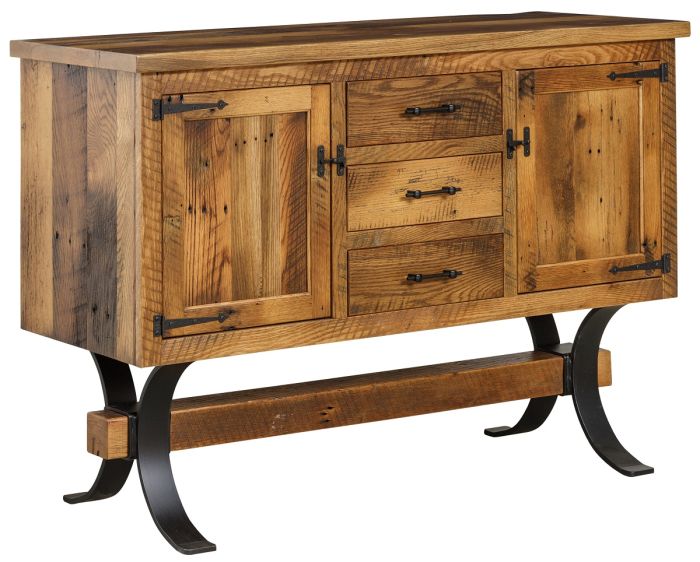
Sideboards vs. Credenzas
Many people use the word sideboard, buffet, and credenza interchangeably to refer to the same item of dining room furniture.
A credenza is an American term for a dining room cupboard used to serve meals, and it may also be used to store or display decorative serving dishes. Credenzas are sometimes smaller and more formal-looking than a sideboard or buffet. They often have no legs and sit directly on the ground. Buffets and sideboards typically have longer or more visible legs that bookend drawers or cupboards. Also, sideboards are different from credenzas, typically, in that they often have hutch tops used for displaying china or decorative items.
Credenzas may have shelving in their centers surrounded by glass display cabinets on either side, or they may be crafted entirely of hardwood.
In the modern-day, many people also refer to them as console tables. Depending on the home’s layout and the space permitted, credenzas may offer the right amount of storage space for miscellaneous items in your living room, dining room, hallway, or home office.
At Countryside Amish Furniture, we want to help you make your home comfortable, beautiful, and functional. Our custom credenzas, sideboards, and buffets can help you feel like you’re entertaining in the dining room of your dreams. Want larger storage options for your dining room or kitchen? Check out our top picks for free-standing cabinets made from solid wood.

